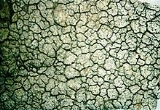
Aspicilia
Encyclopedia
Aspicilia is a genus
of lichen
ized fungi. Most of the species of this genus grow on calcareous and acidic rocks and most of the taxa prefer temperate and arctic habitats.
means of propagation such as isidia
(column-like structures of fungal and algal cells normally found on the top-side or outer cortex of the lichen) and soredia (structures that produce soralia, granule-like masses of intertwined fungal and algal cells occurring on top of the cortex and on the margins).
They have characteristic ascomata which are mostly immersed but occasionally emergent. They have 4 to 8 spored asci
that are cylindrical to club-shaped. Their ascospores are typically ellipsoid to globose in shape, colorless and thin-walled. They often contain β-orcinol depsidones (secondary metabolite
s of lichens) such as norstictic and stictic acids; others have fatty acids or triterpenes. In genus Aspicilia dramatic changes in growth forms are very common, and some taxa may display extreme transitions within the same population or even changes within the same thallus.
Genus
In biology, a genus is a low-level taxonomic rank used in the biological classification of living and fossil organisms, which is an example of definition by genus and differentia...
of lichen
Lichen
Lichens are composite organisms consisting of a symbiotic organism composed of a fungus with a photosynthetic partner , usually either a green alga or cyanobacterium...
ized fungi. Most of the species of this genus grow on calcareous and acidic rocks and most of the taxa prefer temperate and arctic habitats.
Description
Members of this genus are weakly cracked to distinctly areolate, with a scattered to whole thalli. Some of the species of this genus are disc-shaped with plicate lobes at the circumference; these lobes may appear chalky white, grayish, greenish or brownish. Some possess vegetativeVegetative reproduction
Vegetative reproduction is a form of asexual reproduction in plants. It is a process by which new individuals arise without production of seeds or spores...
means of propagation such as isidia
Isidium
An isidium is a vegetative reproductive structure present in some lichens. Isidia are outgrowths of the thallus surface, and are corticated , usually with a columnar structure, and consisting of both fungal hyphae and algal cells...
(column-like structures of fungal and algal cells normally found on the top-side or outer cortex of the lichen) and soredia (structures that produce soralia, granule-like masses of intertwined fungal and algal cells occurring on top of the cortex and on the margins).
They have characteristic ascomata which are mostly immersed but occasionally emergent. They have 4 to 8 spored asci
Ascus
An ascus is the sexual spore-bearing cell produced in ascomycete fungi. On average, asci normally contain eight ascospores, produced by a meiotic cell division followed, in most species, by a mitotic cell division. However, asci in some genera or species can number one , two, four, or multiples...
that are cylindrical to club-shaped. Their ascospores are typically ellipsoid to globose in shape, colorless and thin-walled. They often contain β-orcinol depsidones (secondary metabolite
Secondary metabolite
Secondary metabolites are organic compounds that are not directly involved in the normal growth, development, or reproduction of an organism. Unlike primary metabolites, absence of secondary metabolities does not result in immediate death, but rather in long-term impairment of the organism's...
s of lichens) such as norstictic and stictic acids; others have fatty acids or triterpenes. In genus Aspicilia dramatic changes in growth forms are very common, and some taxa may display extreme transitions within the same population or even changes within the same thallus.
Classification
Previously placed in the family Hymeneliaceae, phylogenetic analyses indicate that the genus is better placed in the family Megasporaceae.Species list
- A. almorensis
- A. alphoplaca
- A. alpina
- A. caesiocinerea
- A. calcarea
- A. californica
- A. cernohorskyana
- A. chadefaudiana
- A. cinerea
- A. coerulea
- A. contorta
- A. crespiana
- A. desertorum
- A. dwaliensis
- A. endochlora
- A. epiglypta
- A. excavata
- A. flavida
- A. fructiculosa
- A. grisea
- A. griseocinerea
- A. intermutans
- A. hoffmannii
- A. laevata
- A. leprosescens
- A. maculata
- A. melanaspis
- A. moenium
- A. myrini
- A. oxneriana
- A. parasitica
- A. praeradiosa
- A. prevostii
- A. quartzitica
- A. recedens
- A. simoënsis
- A. subcandida
- A. subcircinata
- A. subdepressa
- A. tuberculosa
- A. uxoris
- A. verrucigera

